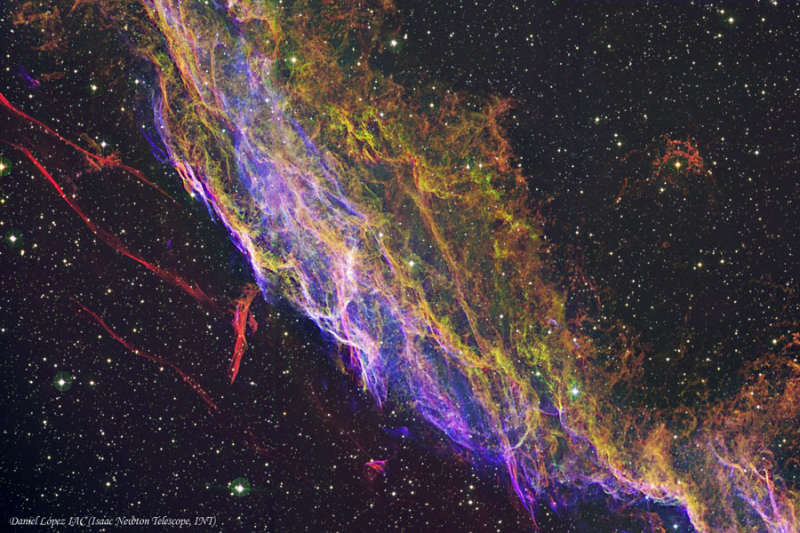Credit & Copyright: Daniel Lopez
(Observatorio del
Teide)
Explanation:
Wisps like this are all that remain visible of a Milky Way star.
About 7,500 years ago that star exploded in a
supernova leaving the
Veil Nebula, also known as the Cygnus Loop.
At the time, the expanding cloud
was likely as bright as a crescent Moon, remaining
visible for weeks to people living at the dawn of
recorded history.
Today, the resulting supernova remnant
has faded and is
now visible only through a small telescope
directed
toward the
constellation of the Swan
(Cygnus).
The remaining Veil
Nebula is physically huge, however, and even though it lies about 1,400
light-years distant, it covers over five times the size of the
full Moon.
In images of the
complete Veil Nebula,
studious readers
should be able to identify the above filaments on the lower left.
The above image is a mosaic from the 2.5-meter
Isaac Newton Telescope at
Roque de los Muchachos
Observatory in the
Canary Islands.
New Mirror:
APOD now available in Arabic from Algeria
1999 2000 2001 2002 2003 2004 2005 2006 2007 2008 2009 2010 2011 2012 2013 2014 2015 2016 2017 2018 2019 2020 2021 2022 2023 2024 2025 |
Yanvar' Fevral' Mart Aprel' Mai Iyun' Iyul' Avgust Sentyabr' Oktyabr' Noyabr' Dekabr' |
NASA Web Site Statements, Warnings, and Disclaimers
NASA Official: Jay Norris. Specific rights apply.
A service of: LHEA at NASA / GSFC
& Michigan Tech. U.
|
Publikacii s klyuchevymi slovami:
NGC 6992 - Veil Nebula - supernova remnant - tumannost' Vual' - ostatok Sverhnovoi
Publikacii so slovami: NGC 6992 - Veil Nebula - supernova remnant - tumannost' Vual' - ostatok Sverhnovoi | |
Sm. takzhe:
Vse publikacii na tu zhe temu >> | |
